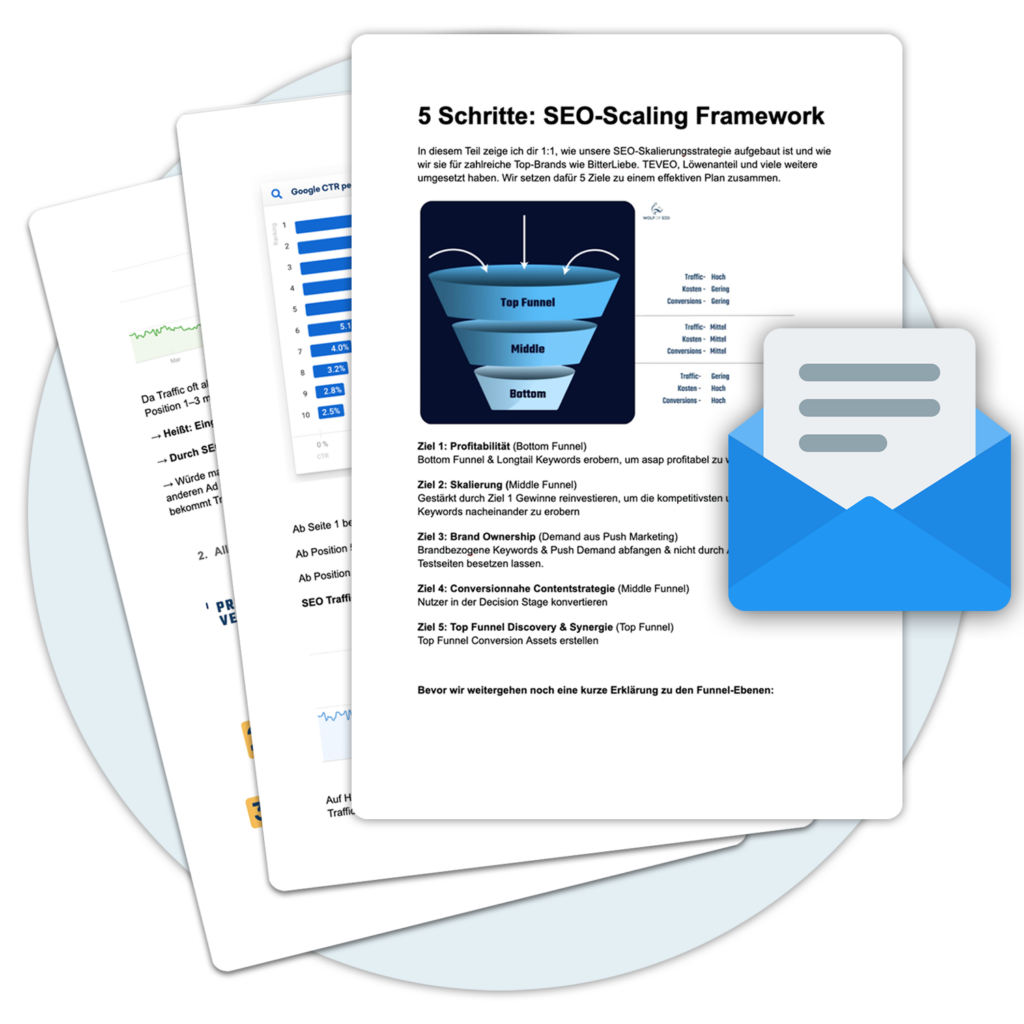What are sitelink extensions?
Sitelink extensions are a feature within Google AdWords that allows advertisers to add additional links to their main ad. These links take the user directly to specific subpages or landing pages located on the advertiser's website. The primary function of these sitelinks is to provide users with faster access to information that may be of particular interest to them, such as opening hours, specific products or special offers.
The advantage of including sitelink extensions in ads is that they increase the visibility of the ad by taking up additional space on the search results page. This not only improves the chance of the ad being noticed, but can also lead to a higher click-through rate as the ad offers more relevant information directly in the search results. Sitelinks are usually only displayed for ads that appear either above or below the organic search results. Search results appear.
Customization and possible applications
Werbetreibende haben die Möglichkeit, Sitelinks manuell zu erstellen und individuell mit Beschreibungen, Zeitplänen für die Anzeigenschaltung sowie für zeitlich begrenzte Aktionen zu konfigurieren. Jeder Sitelink muss dabei eine eigene Ziel-URL haben, um effektiv auf die entsprechenden Unterseiten oder spezifische Inhalte der Website zu leiten. Die Anpassungsfähigkeit von Sitelinks ermöglicht eine gezielte Ausrichtung auf die Suchanfragen und Absichten der Nutzer, was die Werbeeffizienz deutlich steigern kann.
Management and display of sitelinks
The management of sitelink extensions is flexible and can take place at different levels of the Google AdWords account, e.g. at account, campaign or ad group level. This enables a targeted and dynamic adjustment of the sitelinks, depending on the specific requirements and objectives of the advertising campaigns. In terms of presentation, sitelinks take on different formats depending on the device type (PC, laptop or cell phone), their position and other influencing factors, such as images, carousel formats or as expandable options, which further increases interactivity and user-friendliness.
The functionality of sitelinks not only offers a more direct and specific interaction with users, but also enables advertisers to increase the efficiency of their Online Marketing-activities through detailed click statistics, conversion tracking and performance analysis. The use of sitelinks itself is free of charge, but the costs for the visits generated by clicks on the sitelinks are charged according to the usual AdWords billing model. This may result in an increased investment, but should pay for itself through an increased click-through rate and better campaign performance.
Areas of application for sitelink extensions
Sitelink extensions offer a variety of uses within the digital advertising landscape. Their flexibility and customizability make them a valuable tool in a range of Online Marketing-strategies. They can be used in search campaigns, video campaigns on YouTube and AdSense for search results pages. This wide range of applications allows advertisers to target their audience across different platforms and search contexts.
Use in search campaigns
In search campaigns, sitelink extensions allow advertisers to direct users directly to specific and relevant subpages of their website. This not only improves the user experience by simplifying access to desired information, but also increases the effectiveness of campaigns by targeting prospects. Whether it's opening hours, specific product pages or contact forms, sitelinks can lead users directly to the information they are looking for based on their search queries and intentions.
Application for video campaigns
Sitelink extensions also play an important role in video campaigns, especially on YouTube. They make it possible for users who have become aware of a brand or product through video content to receive further information without detours or to make a purchase directly. This direct linking of visual advertising content with corresponding landing pages not only supports the purchase decision process, but also promotes interaction with the brand.
Use in AdSense for search results pages
AdSense for search results pages provides another valuable platform for the use of sitelink extensions. Through the targeted placement of sitelinks in the ads that appear on AdSense search results pages, advertisers can increase their brand's visibility and improve the Relevance of their ads for users' search queries. This can lead to an increased click-through rate and improved conversion rates, as the ads are supplemented with additional, relevant content through the sitelinks.
To summarize, sitelink extensions can be seen as an efficient way of Range and effectiveness of online advertising campaigns. Through their application across different platforms and campaign types, they offer advertisers the flexibility to address their target groups with customized and relevant information, thereby increasing their engagement and interaction with the brand.
Advantages of using sitelink extensions
Die Nutzung von Sitelink-Erweiterungen bringt eine Reihe von signifikanten Vorteilen mit sich, die die Leistung von Werbekampagnen auf Google erheblich steigern können. Zum einen erhöhen sie die Sichtbarkeit der Anzeigen, indem sie mehr Raum auf der Suchergebnisseite einnehmen. Dies führt nicht nur zu einer verbesserten Wahrnehmung durch die Nutzer, sondern kann auch die Klickrate (CTR) signifikant erhöhen. Eine höhere Klickrate bedeutet in der Regel mehr Verkehr auf der Website, was wiederum die Möglichkeiten für Konversionen erhöht.
Increased user interaction and targeted approach
By providing direct links to relevant subpages, advertisers can improve the user experience and encourage user interaction. By directing users to the content they are looking for without detours, satisfaction is increased, which can lead to a higher conversion rate. In addition, targeting users based on their search queries and intentions allows for more effective ad targeting, which can increase conversion rates. Relevance and effectiveness of the campaign.
Flexibility and personalization
Sitelink extensions offer a high degree of flexibility and personalization. Advertisers can create sitelinks manually and add optional text, allowing for targeted communication. Sitelinks can also be scheduled, which is particularly useful for time-limited offers or seasonal campaigns. This flexibility allows campaigns to be dynamically adjusted and ad content to be continuously optimized.
Incorporating sitelink extensions into online advertising campaigns therefore offers a variety of benefits that can help attract user attention, improve the user experience and ultimately boost ad performance. With increased visibility, improved user interaction and the ability to personalize and target, sitelink extensions are a powerful tool in the Online Marketing.
Creation and personalization of sitelinks
The creation and personalization of sitelinks enables advertisers to adapt their ads individually to the needs and interests of their target group. Sitelinks offer the possibility of placing additional links below the main ad that lead directly to specific subpages on a website. These can contain information such as opening hours, specific products, important company pages, forms, product categories or special offers.
Manual creation and optimization
Advertisers have the option to create sitelinks manually to have maximum control over the content displayed. Each sitelink can contain an optional description that provides users with further insights and allows the Relevance of the ad is increased. By specifying specific destination URLs for each link, advertisers can provide users with a targeted experience that aims to effectively fulfill their search intent. The ability to schedule sitelinks for specific time periods makes it easy to promote limited-time offers or seasonal campaigns without having to constantly make manual adjustments.
Personalization for maximum effectiveness
The personalization of sitelinks plays a decisive role in their effectiveness. Short, concise wording is essential to get the message across quickly and effectively. Each sitelink should be designed to offer clear added value that goes beyond the main ad. By carefully selecting and designing sitelinks, advertisers can increase user engagement and improve the likelihood of conversion. Customizability allows advertisers to optimize not only the content but also the timing of sitelink placements to further increase ad relevance and performance.
Overall, the creation and personalization of sitelinks makes it easier for advertisers to target their audience with relevant and useful additional information below their main ads. This increased customizability and targeting leads to an improved user experience and can contribute significantly to increased campaign performance.
Management and optimization of sitelinks
Effective management and optimization of sitelinks is critical to realizing the full potential of these extensions for digital advertising campaigns. Sitelinks offer advertisers the flexibility to make their campaigns more dynamic and tailored to specific subpages or offers. However, this requires continuous monitoring and fine-tuning to ensure that sitelinks are always providing maximum value.
Strategies for managing sitelinks
Managing sitelinks involves adding, editing, scheduling and removing these extensions at account, campaign or ad group level. A clear structure and organization of sitelinks can help to avoid overlaps and maintain clarity. It is advisable to create specific sitelinks for each campaign or ad group that correspond directly with the objectives and content of the respective advertising measure. The ability to plan sitelinks in a targeted manner makes it possible to respond effectively to seasonal events, special offers or other time-limited activities.
Optimization of sitelinks for increased performance
The optimization of sitelinks is an ongoing process that aims to improve the Relevance and effectiveness of the sitelinks on an ongoing basis. This includes the regular evaluation of click statistics and performance data, including conversion rates. Such analyses make it possible to evaluate the performance of individual sitelinks and make adjustments where necessary. Sitelinks that show high performance should be retained or further optimized, while less successful sitelinks should be adjusted or replaced. Fine-tuning the descriptions and the associated URLs can also help to increase the click-through rate and conversion.
Another important aspect of optimization is to use conversion tracking for the landing pages reached via sitelinks. This tracking provides valuable insights into the behavior of users after clicking on a sitelink and makes it possible to measure the direct influence of sitelinks on campaign goals. By analyzing this data, you can not only increase the effectiveness of the sitelinks, but also gain deeper insights into the preferences and needs of the target group.
Through the targeted management and continuous optimization of sitelinks, advertisers can ensure that their ads achieve maximum success. This not only leads to increased visibility and an improved user experience, but also makes a significant contribution to increasing conversion rates and the efficiency of the advertising strategy. Online Marketing-Activities at.
Conversion tracking and performance measurement
Conversion tracking and performance measurement are critical components in optimizing online advertising campaigns, especially when using sitelink extensions. These tools allow advertisers to not only track the number of clicks on their sitelinks, but also to understand how these interactions lead to valuable actions, such as the purchase of a product or newsletter sign-up. Insight into such data can significantly influence strategic decisions and help increase campaign effectiveness.
Implementation of conversion tracking
The implementation of a robust conversion tracking system provides information about which sitelinks have the highest conversion rate and which pages or offers appeal to users the most. By placing conversion tags on the target landing pages of sitelinks, advertisers can accurately track what actions users take after clicking on a sitelink. This enables a more precise allocation of conversions to specific campaigns or ad groups, which in turn simplifies the adjustment of the advertising strategy.
Evaluation of performance data
In addition to conversion tracking, the continuous evaluation of performance data is essential. Detailed click statistics, including the number of clicks, the click-through rate (CTR) and the average cost per click (CPC), provide important insights into the effectiveness of individual sitelinks. In addition, performance data allows trends to be identified, such as seasonal fluctuations or changes in user behavior, thus enabling a proactive adjustment of the campaign strategy. Analyzing this data can not only help to increase profitability, but also improve the user experience through more relevant and targeted content.
The use of conversion tracking and performance measurement thus forms a solid basis for data-driven decisions in the design and optimization of advertising campaigns with sitelink extensions. Effective analysis and evaluation of this data contributes significantly to maximizing campaign performance and helps to use investments in online advertising in a targeted and efficient manner.
Costs and budgeting of sitelink extensions
Integrating sitelink extensions into online advertising campaigns is a measure that may involve additional costs, but also has the potential to significantly increase return on investment (ROI). It is important to understand what the cost structures are and what factors should be considered when budgeting to ensure an efficient allocation of marketing resources.
Impact on total costs
The use of sitelink extensions is free of charge. The costs arise from the clicks on the sitelinks that lead to the stored target URLs. These clicks are billed according to the usual cost-per-click (CPC) model, which means that advertisers only incur costs when users actually click on the sitelinks. However, it should be noted that the increased visibility and Relevance of the ads through sitelinks can potentially lead to an increase in the click-through rate (CTR), which in turn can influence the overall costs of the campaign.
Budgeting for optimum performance
When planning the budget for campaigns that use sitelink extensions, advertisers should keep in mind the potential increase in click-through rate and the associated costs. It's a good idea to analyze historical data to get a sense of how sitelinks impact costs and campaign performance. Flexible budget planning that allows room for adjustments is key to reacting to performance data and optimizing the budget accordingly. In addition, setting a fixed daily or monthly budget can help keep spending under control while trying to maximize visibility and interaction rates.
In practice, this means that advertisers should not only consider the direct costs incurred by clicks on sitelinks, but also the indirect effects on the overall performance of the campaign. By continuously monitoring and analyzing campaign data, advertisers can use their budget efficiently and make adjustments to find the balance between cost control and campaign optimization.
Best practices and guidelines for effective sitelinks
To maximize the effectiveness of sitelink extensions in online advertising campaigns, advertisers should follow certain best practices and guidelines. These not only help to improve the performance of the sitelinks, but also to optimize the user experience and the Relevance of the advertisements.
Targeted and relevant sitelinks
It is essential that the selected sitelinks are directly relevant to the main ad and offer clear added value for the user. The links should lead to specific subpages that complement the content of the ad, such as detailed product information, contact pages or special offers. A strategic selection and targeting of sitelinks can increase the click-through rate and lead users directly to the information they are looking for.
Short and concise texts
Für die Benennung der Sitelinks ist es empfehlenswert, kurze und prägnante Texte zu verwenden, die klar kommunizieren, was den Nutzer auf der Ziel-Seite erwartet. Lange oder unklare Linktexte können Nutzer verwirren und von einem Klick abhalten. Des Weiteren sollte jeder Sitelink eine einzigartige Ziel-URL to have the thematic Relevance and Duplicate Content to avoid.
Optimization for mobile devices
With the increasing use of mobile devices, it is important that sitelinks are also optimized for smaller screens. This means that text should be designed to be easily readable on mobile devices and target landing pages should be mobile-friendly. A positive mobile user experience can significantly increase interaction rates and contribute to the overall performance of the campaign.
Regular review and adjustment
Regularly reviewing the performance of sitelinks is a critical aspect of their optimization. Performance data should be continually analyzed to understand which sitelinks are performing best and which should be adjusted or replaced if necessary. The flexibility to change sitelinks based on campaign performance, seasonal trends or special promotions allows advertisers to keep their ads current and relevant.
By following these best practices and guidelines, advertisers can significantly increase the effectiveness of their sitelink extensions. Careful selection, design and continuous optimization of sitelinks will help increase ad visibility, improve the user experience and ultimately achieve the desired campaign goals.
« Back to Glossary Index






